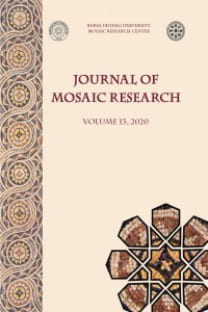Mozaikler Üzerinde Betimlenen Deniz Taşıtlarının İkonografsi ve Deniz Arkeolojisi Açısından Önemi
Bu makalede, Suriye, Lübnan, Ürdün ve İsrail’den Mısır’a kadar olan alanda, Doğu Akdeniz kıyılarının mozaiklerinde betimlenen antik gemilerin ikonografsi ele alınmaktadır. Sadece Doğu Akdeniz’de değil, deniz taşımacılığı ticaret için en önemli nakliye araçlarından biri olduğundan, sanatçı da sanat eserlerinde konu olarak sıkça gemileri kullanmıştır. Gemiler fresklerde de tasvir edilmiştir (örneğin Kudüs’teki Kutsal Kabir Kilisesi’nin içindeki St. Vartan Kilisesi’ndeki bir yelkenli teknenin çizimi. Mozaikler, sikkeler ve hatta Akko/ İsrail’deki Haçlı Kalesi’ndeki duvar kazımaları gibi). Antik çağlarda sanatçılar betimledikleri nesnenin kesin bir görüntüsünü eserleri üzerinde yansıtmaya çalışmışlardır ve bunun da araştırılan teknelerin tam bir görünümünü anlamamıza yardımcı olan ve çağdaş mozaik sanatında yaygın olmayan bir eğilimi yansıttığını söylemek önemlidir. Burada sözü edilen mozaikler büyük çoğunlukla 1 cm² büyüklüğündeki küp tesseralardan üretilmiş olmakla birlikte yüz betimlerinde sıklıkla daha küçük boyuttaki küpler kullanılmıştır. Gemi betimli mozaikler kiliseler, kamu ve özel yapılar hatta bir harmanyeri olmak üzere farklı yerlerde tespit edilmiştir. Yapılardaki gemi betimleri çoğunlukla Yunan mitolojisi (Ariadne ile beraber bir bottaki Thesaurus) ve Nilotik sahnelerde görülürken, kiliselerde madalyonlarda karşımıza çıkmaktadır. Bu makalede ele alınan üzerinde sazdan bir tekne betimi olan en erken tarihli mozaik El-Amarna / Mısır’da bulunmaktadır ve MÖ 1. yüzyıla tarihlenmektedir. Ahşap teknelerden farklı olarak, antik çağ sazdan teknelerin kalıntıları zamanla çürümeleri nedeniyle bulunamamıştır. Bununla birlikte, saz teknelerinin kullanımları edebiyat ve sanattan bilinmektedir. Ayrıca, MS 2. yüzyıldan itibaren kiliseler ve zengin evlerin mozaiklerle dekore edilmesi bu bölgede ortak bir gelenek haline gelmiştir.
Iconography of Marine Vessels Depicted in Mosaics and Its Importance to Marine Archaeology
This article deals with the iconography of ancient ships, depicted in mosaics of the Eastern Mediterranean coast, from Syria, Lebanon, Jordan, Israel to Egypt. As shipping was one of the most important transports for trade, and not only in the Mediterranean Region, artists frequently used ships as a subject of their artworks.Ships are depicted on frescoes (e.g. a drawing of a sailing boat in the Church of St. Vartan in the Church of the Holy Sepulchre in Jerusalem. Gibson 1994: 34-42), mosaics, coins, even engraved on walls, such as on the wall at the crusader castle in Akko Israel. It is important to mention that in ancient times artists tried to conveya precise image of the objects they represented, thing that helps us to understand the exact appearance of the researched boats; a trend not common in contemporary mosaic art.The mosaics we are referring to here were predominantly made from tesserae cubes measuring 1 sq. centimeter, but often smaller cubes were used to depict faces (Figs. 11, 12). Mosaics depicting ships have been discovered in various places such as churches (Fig. 12), public and private houses (Figs. 8, 11, 12), even under a threshing-foor (Fig. 5). In buildings, they were frequently included in stories (Fig. 8) often from Greek mythology (Thesaurus on a boat with Ariadne, Daszewski 1977: pl. 30) and in churches in medallions (Fig. 13).The earliest mosaic we describe in this article is the reed boat from El-Amarna, Egypt (Fig. 14), from the 1st century BC. Unlike wooden boats, remains from ancient reed boats have not been found, since they decay with time. Nevertheless, their uses are known to us from literature and artworks. Furthermore, from the 2nd century AD and onwards, decorating churches (Fig. 13) and rich houses (Figs. 8, 11, 12) with mosaic foors started tobecome a common custom in this region.
___
- Avissar 1998 M. Avissar, “Lod – A Mosaic Floor”, ExcIsr 17, 169-172.
- Avi-Yonah 1972 M. Avi-Yonah, “The Haditha Mosaic Pavement”, IEJ 22, 118-122.
- Basch 1987 L. Basch, Le Musée Imaginaire de la Marine Antique, Athens.
- Casson 1971 L. Casson, Ships and Seamanship in the Ancient World, New Jersey. Daszewski 1977 A. W. Daszewski, Nea Paphos II, La mosaïque de Thésée, Vasovie.
- Daszewski 1985 A. W. Daszewski, Corpus of Mosaic from Egypt I: Hellenistic and Early Roman Period, Mainz.
- Gibson 1994 S. Gibson, “The Ship Drawing“, S. Gibson – J. E. Taylor (eds.), Beneath the Church of the Holy Sepulchre, Jerusalem: The Archaeology and Early History of Traditional Golgotha (Palestine Exploration Fund Monograph Series Major 1), London, 25-50.
- Grossmann 2011 E. Grossmann, Marine Craft in Ancient Mosaics of the Levant, BARIntSer 2249, Oxford.
- Linder - Kahanov 2003 E. Linder - Y. Kahanov, The Ma‘agan Michael Ship, Haifa.
- Meyboom 1995 P. G. P. Meyboom, Palestrina, Early Evidence of Egyptian Religion in Italy, Leiden, New-York, Cologne.
- Parker 1992 A. J. Parker, “Cargos, Containers and Stowage: the Ancient Mediterranean”, IntJNautA 21, 2, 89-100.
- Patrich - Tsafrir 1993a J. Patrich – Y. Tsafrir, “Beith Loya, Horvat”, E. Stern (ed.), The New Encyclopedia of Archaeological Excavations in the Holy Land, Jerusalem, 210-213.
- Patrich - Tsafrir 1993b J. Patrich – Y. Tsafrir, “A Byzantine Church Complex at Horvat Beith Loya”, Y. Tsafrir (ed.), Ancient Churches Revealed (Israel Exploration Society), Jerusalem, 265-272. Piccirillo 1993 M. Piccirillo, The Mosaic of Jordan, Amman. Raban 1988 A. Raban, “The Ship from Migdal Nunia”, Sefunim 7, 48-55.
- Stemm – Kingsley 2013 G. Stemm - S. Kingsley, Oceans Odyssey 3, The Deep-Sea Tortugas Shipwreck, Straits of Florida: A Merchant Vessel from Spain‘s 1622 Tierra Firme Fleet, Oxford and Oakville.
- Stronk 1992-93 J. P. Stronk, “Greek sailing merchant-ships, c. 500 - 330 B.C. A preliminary research”, Talanta 24-25: 117-140.
- ISSN: 1309-047X
- Başlangıç: 2008
- Yayıncı: Ululdağ Üniversitesi, Mozaik Araştırlmaları Merkezi
Sayıdaki Diğer Makaleler
Etkileşim Kompozisyonu Üzerine Bazı Düşünceler - Yüzey
Antakya Magdouh Mozaiği’nin Üçüncü Boyutu
Beyhan BOLOK HİSARLIGİL, Hakan HİSARLIGİL
Marcelo MENDES PINTO, Fátima ABRAÇOS, Licínia WRENCH
Latium’un Güney Kıyılarındaki Cumhuriyet ve İmparatorluk Dönemi Mozaikleri. Nicel Bir Analiz
Lod Mozaikleri Üzerindeki Deniz Sahneleri
Amir GORZALCZANY, Baruch ROSEN
Miguel PESSOA, lsa SIMOES, Sonia VICENTE, Ana Luisa Ravara MENDES
Türkmenistan, Gonur Depe, Tunç Çağı Nekropol Mozaikleri
Galina E. VERESOTSKAYA, Nadezhda A. DUBOVA, Anatolij M. YUMINOV, Natalia A. KOVALEVA
Mozaikler Üzerinde Betimlenen Deniz Taşıtlarının İkonografsi ve Deniz Arkeolojisi Açısından Önemi
